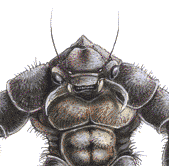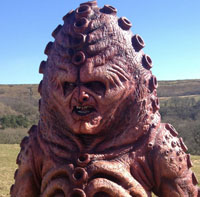Appearances
The autons make their debut in the first Third Doctor story, Spearhead from Space, making them the third race to appear in my list from that era (which is itself the only era to appear on the list more than once). They reappear only once more in the classic series, in Terror of the Autons at the start of the next season, and twice in the modern series, most notably in the Ninth Doctor’s debut story, Rose.
Outside of the TV series, they featured in a three-part straight-to-video series in the 1990s which, as with Sontarans and Zygons, indicates a certain degree of popularity. That, of course, existed outside the Doctor Who license since autons, like many other original races, have separate copyright status. But in material officially licensed by the BBC, they have so far appeared in three novels, two with the Sixth Doctor, and one with the Tenth. In the audios, they have faced the Doctor only once to date, but they have appeared in a Torchwood audio and a four-part box set featuring UNIT that, in some respects, updates Spearhead from Space for the 2010s. And, as one might expect, there are also a parade of shorter appearances in comics and short stories.
Description and Biology
The autons are not organic creatures, but plastic objects animated by the Nestene Consciousness. The Nestene themselves are alien but are less frequently faced as direct opponents than the autons proper (typically only at the end of an auton story, if then). So I will be dealing with them later.
It’s possible to classify the autons into three basic types. The standard version are the animated plastic mannequins, often in the form of shop window dummies; these are the main focus in the two classic era stories, and in Rose. They are, in effect, the Nestene’s foot soldiers, although presumably, they use other forms when invading planets that aren’t Earth. Secondly, there are more sophisticated plastic humanoids designed to duplicate specific people and used to infiltrate human society and lay the groundwork for a full-scale invasion. Finally, there are animated objects such as dolls, telephone cords, and wheelie bins – I’m going to exclude these from the post since they vary too much and animated objects often already exist with descriptions in RPGs.
The mannequins and animated objects possess only a very small part of the Nestene Consciousness, so far as one can tell, and simply stop working when the animating Nestene dies or is driven off. This is not, however, true of the auton ‘duplicates’ used for infiltration, which are evidently capable of independent existence without the presence of a Nestene; they are entirely controlled by it while it is present, but once the link is severed, they are able to continue as separate entities, sometimes unaware of what they really are.
Game Attributes
There is little evidence that autons are significantly stronger than humans and the ‘dummy’ autons are probably less agile – although effective enough at shooting, which is a more overriding consideration in most systems. Where they excel is their physical resilience, since they don’t tire and have no blood or vital organs that can be injured by bullets or sharp stabbing weapons. Weapons that bludgeon or slice are a different matter since the plastic they are usually made of does not seem to be exceptionally tough. But even then, losing a limb is no problem to an auton beyond the mere physical inconvenience of not being able to use it. It’s worth noting that, in some systems (especially some older ones), this could make an auton an unusually effective opponent. Since they don’t seem to be so on the show, this may require some adjustment to counteract the advantages they would gain. Being mass-produced, it is unlikely that the mannequin-style autons show much variation in their physical statistics, although the duplicates will necessarily be less consistent in form.
Auton duplicates seem to be capable of some independent thought, animated by a larger portion of the Nestene Consciousness and, in some cases, being able to survive as discrete beings after its departure. Thus, they can be given their own mental statistics, although there is little to argue that these would be any better than those of humans. Depending on how the attributes are used in different systems, they might even be lower. There’s a case to be made that they aren’t very charismatic, but they do seem to be at least reasonably good at deceiving humans into thinking they’re just behaving strangely, something that could be directly tied to charisma (or equivalent) in some systems.
The mannequin autons are a different matter. They seem to be directly controlled by the Nestene, so that most of what they do would be directed by its mental statistics, rather than their own. In D&D terms, for example, they are essentially ‘plastic golems’ and can be treated in a similar manner. They have essentially no intelligence of their own although, again, how different systems may handle that is likely to vary. For the same reason, while the Nestenes themselves may be different, independent autons do not necessarily have any particular alignment.
Special Abilities
In some episodes, we see auton duplicates controlling other autons, primarily the non-humanoid ‘animated object’ sort. However, this can probably best be described as the Nestene channelling their own powers through the perceptions of the duplicate. That is to say, it’s an ability of the Nestene, not of the autons.
Other than that, we are left with the concealed guns that the mannequin autons, and some auton duplicates, hide within their wrists. These are regular blasters, powered from some kind of internal energy cell, and seem to be short-range. Not all autons have them – or, if they do, they don’t use them in some circumstances when they’d logically be useful – but they seem reasonably common among the mannequins, and less so for the duplicates. So, for these purposes, I will assume that the typical mannequin has one and the typical duplicate does not.
5E - Auton Mannequin
Medium construct, unaligned
Armour Class: 12 (plastic body)
Hit Points: 34 (4d8+16)
Speed: 20 ft.
STR 12 (+1) | DEX 10 (+0) | CON 18 (+4) |
INT 3 (-4) | WIS 8 (-1) | CHA 1 (-5) |
Combat Skills: Melee Attack +3, Missile Attack +2
Damage Resistances: Lightning, piercing, psychic
Damage Immunities: Poison
Condition Immunities: Charmed, exhaustion, paralysed, poisoned, stunned
Senses: Passive Perception 9
Wrist Gun. Ranged Weapon Attack: +2 to hit, range 30/120 ft., one target. Hit: 2d6 fire damage.
Challenge: ½ (100 XP)
5E - Auton Duplicate
Medium construct, neutral
Armour Class: 10 (natural)
Hit Points: 43 (5d8+20)
Speed: 30 ft.
STR 12 (+1) | DEX 10 (+0) | CON 18 (+4) |
INT 10 (+0) | WIS 10 (+0) | CHA 8 (-1) |
Skills: Deception +1
Combat Skills: Melee Attack +1, Missile Attack +2
Damage Resistances: Lightning, piercing
Damage Immunities: Poison
Condition Immunities: Exhaustion, paralysed, poisoned
Senses: Passive Perception 10
Wrist Gun. Ranged Weapon Attack: +2 to hit, range 30/120 ft., one target. Hit: 2d6 fire damage.
Challenge: ¼ (50 XP)
BRP - Auton Mannequin
STR 1D6+9 (12-13) | CON 1D6+15 (18-19) | SIZ 1D6+9 (12-13) |
POW 2D6 (7) | DEX 1D6+6 (9-10) | |
Hit Points: 16 | Move: 8 | |
Base SR: 5 | Damage Bonus: +1D4 |
Armour: 3-point plastic body
Combat Skills: Brawl 50%, Energy Pistol 60%
BRP - Auton Duplicate
STR 2D6+6 (13) | CON 2D6+12 (19) | SIZ 2D6+6 (13) |
INT 2D6+6 (13) | POW 3D6 (10-11) | |
DEX 3D6 (10-11) | CHA 2D6 (7) | |
Hit Points: 16 | Move: 10 | |
Base SR: 5 | Damage Bonus: +1D4 |
Armour: 1-point plastic body
Skills: Fast Talk 30%, Persuade 40%
Combat Skills: Brawl 25%, Energy Pistol 50%
Plastic Construct: The auton does not need to breathe, eat, or sleep and is immune to disease and poison. If using hit locations, each location must be destroyed separately. If the head is destroyed, the auton cannot sense its surroundings, and ceases to function.
GURPS - Auton Mannequin
ST 12 | DX 10 | IQ 4 | HT 12 |
Thrust: 1d-1 | Swing: 1d+2 | ||
Speed: 6 | Move: 4 |
Advantages: Damage Resistance +2, Doesn't Breathe, Doesn't Eat or Drink, Doesn't Sleep, Injury Tolerance (homogenous, no blood), Innate Attack (burning, 2d), Very Fit
Disadvantages: Automaton, Cannot Speak, Unhealing (total)
GURPS - Auton Duplicate
ST 12 | DX 10 | IQ 10 | HT 12 |
Thrust: 1d-1 | Swing: 1d+2 | ||
Speed: 6 | Move: 6 |
Advantages: Doesn't Breathe, Doesn't Eat or Drink, Doesn't Sleep, Injury Tolerance (homogenous, no blood), Very Fit
Disadvantages: Unhealing (total)
Skills:
Savage Worlds - Auton Mannequin
Agility: d6 | Smarts: d4 | Spirit: d10 |
Strength: d8 | Vigour: d12 |
Skills: Fighting d4, Shooting d6
Edges: Armour +2, Construct, No Vital Organs
Hindrances: Mute
Animated Object: When not being controlled by a Nestene, an auton mannequin is inert and incapable of taking any action.
Pace: 4 Parry: 4 Toughness: 10 (2) Size: 0
Savage Worlds - Auton Duplicate
Agility: d6 | Smarts: d6 | Spirit: d8 |
Strength: d8 | Vigour: d12 |
Skills: Persuasion d6, Shooting d4
Edges: Construct, No Vital Organs
Pace: 6 Parry: 2 Toughness: 8 Size: 0
STA - Auton Mannequin
Control: 9 | Fitness: 11 | Presence: 7 |
Daring: 11 | Insight: 4 | Reason: 4 |
Command: 0 | Security: 2 | Science: 0 |
Conn: 0 | Engineering: 0 | Medicine: 0 |
Stress: 13 | Resistance: 2 |
Traits: Wrist Gun: The auton has a type 1 phaser built into their wrist. Machine 2.
STA - Auton Duplicate
Control: 9 | Fitness: 11 | Presence: 9 |
Daring: 10 | Insight: 7 | Reason: 9 |
Command: 2 | Security: 1 | Science: 0 |
Conn: 0 | Engineering: 0 | Medicine: 0 |
Stress: 12 | Resistance: 1 |
Traits: Machine 1.











